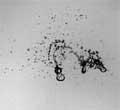Rain behavior in a drop
2009/08/23 Lakar Iraizoz, Oihane - Elhuyar Zientzia

On the road from clouds to the ground, raindrops acquire a certain distribution and are usually drops of different sizes. Scientists have been trying to figure out what happens for a few drops to be larger and a few smaller.
It was suspected that collisions occur between the drops, which causes a few drops to come together and thicker drops to form, others to remain small, etc. However, French researchers who study fluid dynamics did not believe that there were many interactions between the drops when it rains, so they decided to study a drop to see what happened to it.
They dropped the drops of a tap and recorded the fall with a high-speed camera. After the analysis of the engraving, they observed that at greater speed the shape of the drops changes: first they adopt the shape of the crepes, that is, the flattened ones are placed, then the shape of a pan or bag, with the ass up, and finally they are exploited and distributed in several droplets.

This is due to increased air resistance as drops gain speed. From a given moment, the air resistance is superior to the internal cohesion force of the thick drops of water, breaking the thick drops.
The droplets extracted from this break are of different sizes and according to the researchers, they have the same characteristics as those that fall to the ground when it rains. Therefore, it has been considered that the behavior observed in a single drop is generalizable, leaving aside the shocks and interactions between the drops to explain the behavior of the rain.
Modified conditions
If someone wanted to repeat what was said and went to the kitchen faucet to let the drops fall separately, in order to check that behavior in the drops, he would not get the expected result.
In normal conditions, the drops must travel a distance of about ten meters for the aforementioned alteration and breakage. Up to that distance they do not reach enough speed and the air resistance is not so high as to break the joining forces within the water drop.

Scientists have studied the behavior of drops dropping under the tap. (JR Guillaumin).
In general, the houses do not have such a high height and, even if they had them, they would hardly have a tap ten meters from the ground. Well, in the laboratory of researchers in France they have also not created this type of infrastructure for the experiment. The problem of air resistance has been solved differently, artificially increasing with an upward jet of air in the area where the drop fell to simulate the resistance of the drops.
The truth is that it is curious to know what kind of research scientists move around the world. When a rain shower catches him, no one will begin to think why the drop that touched him in the head is greater than the one that touched him in the arm, and less than the one that touched him in the shoulder... but for physicists it is very important to have basic knowledge, and understanding the phenomena that occur in everyday life is a way to increase that knowledge.
Published in 7k

Gai honi buruzko eduki gehiago
Elhuyarrek garatutako teknologia





